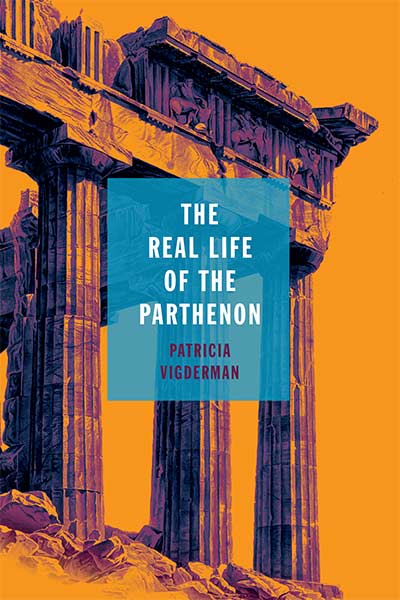
ForeWord talks to Patricia Vigderman about The Real Life of The Parthenon.
THE REAL LIFE OF THE PARTHENON
Ownership battles over the marbles removed from the Parthenon by Lord Elgin have been rumbling into invective, pleading, and counterclaims for two centuries. The emotional temperature around them is high, and steering across the vast past to safe anchor in a brilliant heritage is tricky. The stories around antiquities become distorted by the pull of ownership, and it is these stories that urge Patricia Vigderman into her own exploration of their inspiring legacy in her compelling extended essay, The Real Life of the Parthenon.
Though her journey began at the Parthenon, curiosity edged her further onto the sea between antiquity and the present. She set out to seek the broken temples and amphorae, the mysterious smiles of archaic sculpture, and the finely hammered gold of a funeral wreath among the jumbled streets of modern Athens, the fertile fields of Sicily, the mozzarella buffalo of Paestum. Guided along the way toward the enduring landscapes and fractured history by archeologists, classicists, historians, and artists—and by the desire they inspire—she was caught by ongoing, contemporary local life among the ruins. Gathering present meaning and resonance for the once and future remains of vanished glory, The Real Life of the Parthenon illuminates an important but shadowy element of our common cultural life: the living dynamic between loss and delight.
PRAISE & REVIEWS
Patricia Vigderman’s enthralling account of several forays to the Mediterranean, detailing her search for pleasure and enlightenment in the ancient world, is as rewarding for an armchair traveler as for a first-time or seasoned one.… We accompany her with considerable gratification, stopped by the unexpected image or metaphor, as a traveler is by a new sight. To wander in writing, one needs a very good style. She’s got it.
–Willard Spiegelman, The Wall Street Journal (read full review)
Vigderman approaches her subject evenhandedly, noting that the repatriation of works of art can be seen as a victory for local communities and their sense of identity, but she also spots the questionable ties between the handiwork of an ancient Greek vase painter, say, and the inhabitants of modern-day Paestum. …Behind the examples in this thoughtful book lies the realization that the relationship between the spectator and art is inevitably complex.
–Bruce Boucher, New York Times Book Review
The Real Life of the Parthenon is a great achievement — a scrupulous presentation of demanding issues that is fun to read.
–David Carrier, Hyperallergic (read full review)
“Money, power, and beauty snarl into complex arguments,” writes Vigderman, who thoughtfully questions and probes the issues rather than making judgments for either side…. [She] turns her deep, wide knowledge of culture and artifacts to a discussion that’s too long lacked honesty, clarity of vision, and compassion.”
—ForeWord
In her elegant meditation on beauty and ruin, on the tangled tale of the loss and retrieval of classical artifacts of the West, Patricia Vigderman has fashioned a passionate travelogue that holds in balance long history and our present political moment. Her pilgrimage is a welcome inquiry into cultural ownership and imperial presumption, enlivened with vivid personal responses to art and landscape, searching considerations of celebrated earlier fellow travelers (Goethe, Henry James, Virginia Woolf) as well as lesser known figures–historians, photographers and contemporary archeologists and curators. She brings them all vividly into her exploration of our relation to a shared, often contentious past. Her eye is by turns acute and tender, always keen. One of those rare books that takes a single subject and refracts it into a world.
—Patricia Hampl
“In these richly informed and intensely personal meditations on art and history, Patricia Vigderman traces the life of our classical heritage through the centuries and shows its continuing vitality and significance in the present. Written with equal sensitivity to political debates and aesthetic beauty, The Real Life of the Parthenon deepens our understanding of how the imagination shapes and transforms the past—and how the deep past informs and shapes the imagination of the present.”
—Eva Hoffman, author of Lost in Translation and Human Time